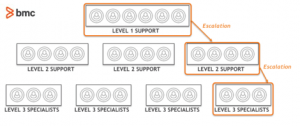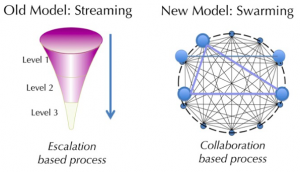In ITSM, a multi-tier support system has been the norm for decades. The classic tiered support structure is widely adopted, and it’s used to fix end-user technical issues and to support IT services and operations. But this approach has a lot of challenges that prevent companies from providing top customer experiences.
In this article, we’ll compare the traditional tiered support model with an emerging favorite—the swarming model for IT support.
Tiered IT support model
A brief history: the tiered, or multi-level, support model has been around since the advent of technology services. Technology services are designed to be scalable, with increased support requests as the system grows. These requests increase exponentially with the expanding userbase. This traditional tiered model, based on standard IT support levels, is challenged today because organizations struggle to improve IT support capabilities all while end users continually ask for faster, better, convenient, and accurate IT support.

Each level has a specific function:
- Level 1 includes a service desk as a well-established IT function. Support agents on this level need not be experts. Automation and self-service may be used to support users and connect support agents operating on subsequent levels. This level resolves basic repetitive issues, like password resets and account information updates.
- Level 2 handles more complex issues that require support from technical personnel. Support agents at Level 2 typically have expertise in specific technologies. The agents may not be the designers, engineers, or programmers of the product, but may have deep knowledge in solving common issues facing end-users.
- Level 3 uses top-level expertise to resolve the most technical issues. This tier includes personnel who have created or are actively involved in architecting, designing, improving, and expanding an IT service or a product.
Any support issue related to technologies or services beyond your organization may be escalated to external vendors at Tier 4.
As technology as entirely transformed in the 21st century, the tiered IT support model is failing in a number of ways:
- Long queues and delays. As service requests keep pouring in and take time to resolve, limited support staff and resources mean new requests are left to wait.
- Siloed knowledge distribution. The solution to issues, including those that are known and repetitive, remains in pockets of knowledge across tiers. The knowledge is not shared between tiers and an issue is not resolved until it’s escalated to the appropriate tier and pocket of knowledge.
- Single communication channel. End users must follow a standard process to access knowledge or information pertaining to their support requests. This is a challenge for higher-tier support engineers who must access and correlate information from multiple issues that are treated through independent communication links only.
- Bouncing tickets. The siloed approach to issue resolution means that support requests often bounce between tiers. A request may sit at a lower tier until appropriate information has been received from a higher tier. Any discrepancy causes additional delays before the request is escalated and solved accurately.
- Agent boredom and burnout. Support staff at specific tiers often receive repetitive request to resolve the same issues. Instead of acquiring knowledge on resolving the issue, the requests are escalated. Solving the same issues repetitively is also a boring task for engineers at higher tiers who may get frustrated or experience burnout.
All of these challenges result in the ultimate drawback: poor customer experience. Overwhelmed support staff, frequent ticket bouncing, and delayed support compromises customer satisfaction and damages your brand’s reputation.
Swarming IT support model: A solution?
Seeking an alternative to the problems inherent in tiered IT support, Cisco pioneered a collaboration-based support model, in 2008, called digital swarming. The Consortium for Service Innovation then adopted the concept into its popular Intelligent SwarmingSM framework.
A swarming IT support model allows individual support agents to see end-to-end issue resolution through collaborative efforts between appropriate engineers and stakeholders within the organization. Teams build, share, and implement knowledge bases across their support staff, thereby resolving frequently repetitive issues faster. The problems are well documented and support staff improve their learning curve, often also sharing the knowledge with end-users.

The swarming support model aims to address the shortcomings of the tiered support model. Instead of the escalation-based support process, the Swarming model follows a collaboration-based process. Swarming support models follow four key principles:
- There are no tiered support levels.
- There are no request escalations between groups.
- The request goes directly to the agent who is most likely or best suited to handle it.
- The assigned agent will see the issue through to resolution.
The interconnected nature of collaborative support offers a number of benefits when applied to a swarming IT support model, including:
- Distributed intelligence. Knowledge pockets and information silos are avoided because resources, tools, and knowledge, are accessible to collaborative teams. Awareness of technology issues and resolution is distributed among the support staff. Support requests are then appropriately assigned to individuals based on availability, functionality, preference and location, among other factors, to realize fast and accurate issue resolution.
- Collaborative communication. The knowledgebase grows across your support department, and it flows easily between individuals. Specialized experts share their expertise and knowledge on resolving known and repetitive issues. Individuals beyond the specialized groups can take advantage of this knowledge and independently solve related issues.
- Immersive environments. The information-rich knowledge base and technology resources are available across the support teams. Like the collaborating support staff, information repositories, tools, and information sources are tightly integrated. Therefore, the decisions at both the individual and collective level are well-informed and data-driven.
Swarming combines the attributes of social networks, especially how the resources and knowledge is accessible and flows between the individuals. While this capability allows for faster issue resolution, it doesn’t inherently slow or reduce the growing number of support requests that successful companies will see—something you must continuously prepare for.







